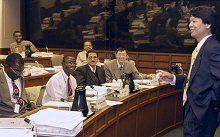
Typical street scene in Santa Ana, El Salvador. (Photo: iStock)
IMF Survey: Getting Plugged In
July 18, 2007

IMF Institute session: course includes identifying early warning signs for potential macroeconomic, financial system weaknesses (IMF file photo)
DISTANCE LEARNING PROGRAM
Dear IMF Survey:
Having recently completed the IMF Institute's Distance Learning course on financial programming and policies, I wanted to record some of my impressions and thank the course organizers before letting too much time elapse. In my view, this course is unique and useful and is of great benefit to all of the member countries of the IMF.
IMF courses on financial programming and policies provide hands-on training for officials on the key interrelations among sectors of an economy and on economic policy analysis. The courses are designed primarily for officials who help to formulate and implement policies for their own countries, but they are equally useful for those of us who monitor economic developments in other countries.
I am an economist in the International Banking and Finance group at the United States' Office of the Comptroller of the Currency, and I am the third of five economists in my group to benefit from this course. Much of our work entails assessing risks to the U.S. banking system from exposure to emerging market economies. In the past, the potential for a currency or sovereign default crisis was the main international risk for U.S. banks because their international lending was primarily conducted from the United States.
Key training tool
However, today, as banks establish a physical presence overseas, they are increasingly vulnerable to a wider array of risks entwined in the threads of a country's macroeconomic, financial, political, and social fabric. Identifying these risks entails a more comprehensive approach to country risk analysis. My colleagues and I view the IMF Institute's financial programming and policies course as a key training tool for effective country risk analysis.
The distance segment of the course required a long period (10 weeks) of working independently through a case study to explore the interrelationships between the various sectors of an economy and to uncover hidden vulnerabilities. These vulnerabilities could be buried in some of the more obscure parts of the economy, but we learned quickly that if they went unaddressed they could have serious adverse effects on the domestic economy, as well as spillover effects on its commercial and financial partner countries.
The work in the distance segment was challenging—requiring us to put in late nights and weekends to complete weekly assignments by the deadlines—especially since it had to be done while we were working at our day jobs. But this segment of the course was also rewarding: the hard work, combined with support from our IMF instructors through a discussion forum and e-mail, ensured that we learned a lot quickly. I soon found that I was able to grasp fully the issues raised each week and to appreciate how they influenced the bigger picture of risk assessment and policy formulation.
Hypothetical IMF program
Upon completing the distance segment, course participants from around the world came together in the two-week residential segment to design a hypothetical IMF program to resolve the vulnerabilities that we had unearthed during the distance segment. This was exciting. Even though we were from very diverse countries, we had something in common: we had each struggled independently with complex problems for many weeks and now we were well prepared to collaborate with our new colleagues.
During this segment, IMF staff provided daily morning lectures on relevant topics to motivate educated and insightful group discussions in the afternoon workshops. The diversity of experiences and perspectives that everyone brought to the discussions pushed each of us out of our comfort zone of conventional thinking and into much deeper analysis, resulting in a better team product.
Each of us also acquired knowledge beyond the case study about the issues and concerns that our colleagues face in their own countries. From my own point of view—given the work we do in the International Banking and Finance Group of the Office of the Comptroller of the Currency—this aspect is very valuable because each member of the my team analyzes a portfolio of countries, not just a single market. I hope and believe, moreover, that my U.S. perspective was also useful to the learning experiences of others in the course.
Early warning signs
In the end, this distance learning course at the IMF Institute taught me a great deal about identifying early warning signs for potential macroeconomic and financial system weaknesses, critically assessing the policies that a country may use to mitigate risks, and pulling these various elements together into a more comprehensive analysis of country risk.
The integrated approach that the course took is something that you cannot get from a text book, and the unique combination of theory and practice sets the IMF course apart from the other courses by fostering "learning by doing" and thus enabling a deeper and more sustained comprehension.
Last, but certainly not least, the cooperative learning environment fostered by the IMF Institute enabled us to build lasting friendships among colleagues and counterparts from around the world. I look forward to working with many of these new friends and colleagues again in the near future.
Geralynn Batista
U.S. Office of the Comptroller of the Currency
Washington, D.C., United States







